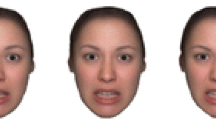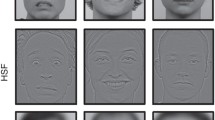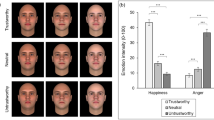Abstract
Studies in animals have implicated the amygdala in emotional1,2,3, and social4,5,6, behaviours, especially those related to fear and aggression. Although lesion7,8,9,10, and functional imaging11,12,13,14, studies in humans have demonstrated the amygdala's participation in recognizing emotional facial expressions, its role in human social behaviour has remained unclear. We report here our investigation into the hypothesis that the human amygdala is required for accurate social judgments of other individuals on the basis of their facial appearance. We asked three subjects with complete bilateral amygdala damage to judge faces of unfamiliar people with respect to two attributes important in real-life social encounters: approachability and trustworthiness. All three subjects judged unfamiliar individuals to be more approachable and more trustworthy than did control subjects. The impairment was most striking for faces to which normal subjects assign the most negative ratings: unapproachable and untrustworthy looking individuals. Additional investigations revealed that the impairment does not extend to judging verbal descriptions of people. The amygdala appears to be an important component of the neural systems that help retrieve socially relevant knowledge on the basis of facial appearance.




Similar content being viewed by others
References
Weiskrantz, L. Behavioral changes associated with ablation of the amygdaloid complex in monkeys. J.Comp. Physiol. Psychol. 49, 381–391 (1956).
Blanchard, D. C. & Blanchard, R. J. Innate and conditioned reactions to threat in rats with amygdaloid lesions. J. Comp. Physiol. Psychol. 81, 281–290 (1972).
Le Doux, J. The Emotional Brain(Simon and Schuster, New York, 1996).
Rosvold, H. E., Mirsky, A. F. & Pribram, K. Influence of amygdalectomy on social behavior in monkeys. J. Comp. Physiol. Psychol. 47, 173–178 (1954).
Kling, A., Steklis, H. D. & Deutsch, S. Radiotelemetered activity from the amygdala during social interactions in the monkey. Exp. Neurol. 66, 88–96 (1979).
Kling, A. S. & Brothers, L. A. in The Amygdala: Neurobiological Aspects of Emotion, Memory, and Mental Dysfunction(ed. Aggleton, J. P.) 353–378 (Wiley-Liss, New York, 1992).
Adolphs, R., Tranel, D., Damasio, H. & Damasio, A. Impaired recognition of emotion in facial expressions following bilateral damage to the human amygdala. Nature 372, 669–672 (1994).
Young, A. W. et al. Face processing impairments after amygdalotomy. Brain 118, 15–24 (1995).
Calder, A. J. et al. Facial emotion recognition after bilateral amygdala damage: differentially severe impairment of fear. Cogn. Neuropsychol. 13, 699–745 (1996).
Broks, P. et al. Face processing impairments after encephalitis: amygdala damage and recognition of fear. Neuropsychologia 39, 59–70 (1998).
Morris, J. S. et al. Adifferential neural response in the human amygdala to fearful and happy facial expressions. Nature 383, 812–815 (1996).
Breiter, H. C. et al. Response and habituation of the human amygdala during visual processing of facial expression. Neuron 17, 875–887 (1996).
Morris, J. S. et al. Aneuromodulatory role for the human amygdala in processing emotional facial expressions. Brain 121, 47–57 (1998).
Tranel, D. & Hyman, B. T. Neuropsychological correlates of bilateral amygdala damage. Arch. Neurol. 47, 349–355 (1990).
Damasio, A. R. Toward a neurobiology of emotion and feeling: operational concepts and hypotheses. Neuroscientist 1, 19–25 (1995).
Lewicki, P., Hill, T. & Czyzewska, M. Nonconscious acquisition of information. Am. Psychol. 47, 796–801 (1992).
Saarni, C., Mumme, D. L. & Campos, J. J. in Handbook of Child Psychology, Vol. 3: Social, Emotional, and Personality Development(ed. Damon, W.) 237–309 (Wiley, New York, 1997).
Tranel, D. in Neuropsychological Assessment of Neuropsychiatric Disorders(eds Grant, I. & Adams, K.M.) 81–101 (Oxford Univ. Press, New York, 1996).
Damasio, H. & Frank, R. Three-dimensional in vivo mapping of brain lesions in humans. Arch. Neurol. 49, 137–143 (1992).
Frank, R. J., Damasio, H. & Grabowski, T. J. Brainvox: an interactive, multi-modal visualization and analysis system for neuroanatomical imaging. NeuroImage 5, 13–30 (1997).
Adolphs, R., Tranel, D., Damasio, H. & Damasio, A. R. Fear and the human amygdala. J. Neurosci. 15, 5879–5892 (1995).
Nahm, F. K. D., Tranel, D., Damasio, H. & Damasio, A. R. Cross-modal associations and the human amygdala. Neuropsychologia 31, 727–744 (1993).
Anderson, N. H. Likableness ratings of 555 personality-trait words. J. Person. Social Psychol. 9, 272–279 (1968).
Ekman, P. & Friesen, W. Pictures of Facial Affect(Consulting Psychologists, Palo Alto, CA, 1976).
Acknowledgements
We thank J. Suhr and J. Nath for technical assistance in testing subjects, D. Krutzfeldt for help in scheduling subjects and H. Damasio for comments on the manuscript. This study was supported by a grant from the National Institute for Neurological Diseases and Stroke.
Author information
Authors and Affiliations
Corresponding author
Rights and permissions
About this article
Cite this article
Adolphs, R., Tranel, D. & Damasio, A. The human amygdala in social judgment. Nature 393, 470–474 (1998). https://doi.org/10.1038/30982
Received:
Accepted:
Issue Date:
DOI: https://doi.org/10.1038/30982
- Springer Nature Limited
This article is cited by
-
Superior bias in trust-related decisions
Current Psychology (2023)
-
Face Your Fears: Virtual reality-based cognitive behavioral therapy (VR-CBT) versus standard CBT for paranoid ideations in patients with schizophrenia spectrum disorders: a randomized clinical trial
Trials (2022)
-
A neuronal social trait space for first impressions in the human amygdala and hippocampus
Molecular Psychiatry (2022)
-
Encoding of facial features by single neurons in the human amygdala and hippocampus
Communications Biology (2021)





